
Alexandra Kennon
Jacob’s Well Natural Area, just northwest of Wimberley, Texas
This story was supposed to be about bluebonnets.
For those who have not spent considerable time visiting or romanticizing rural Texas, bluebonnets are the small, wispy, purplish-blue-colored wildflowers that drape the state’s highway medians and cow pastures in regal robes of indigo each spring. The “Yellow Rose of Texas” may have been responsible for saving the Alamo, but it’s the bluebonnets that wildly contribute to the Hill Country’s natural beauty, and keep tourists and locals alike pulling cars over to snap photographs, year after year.
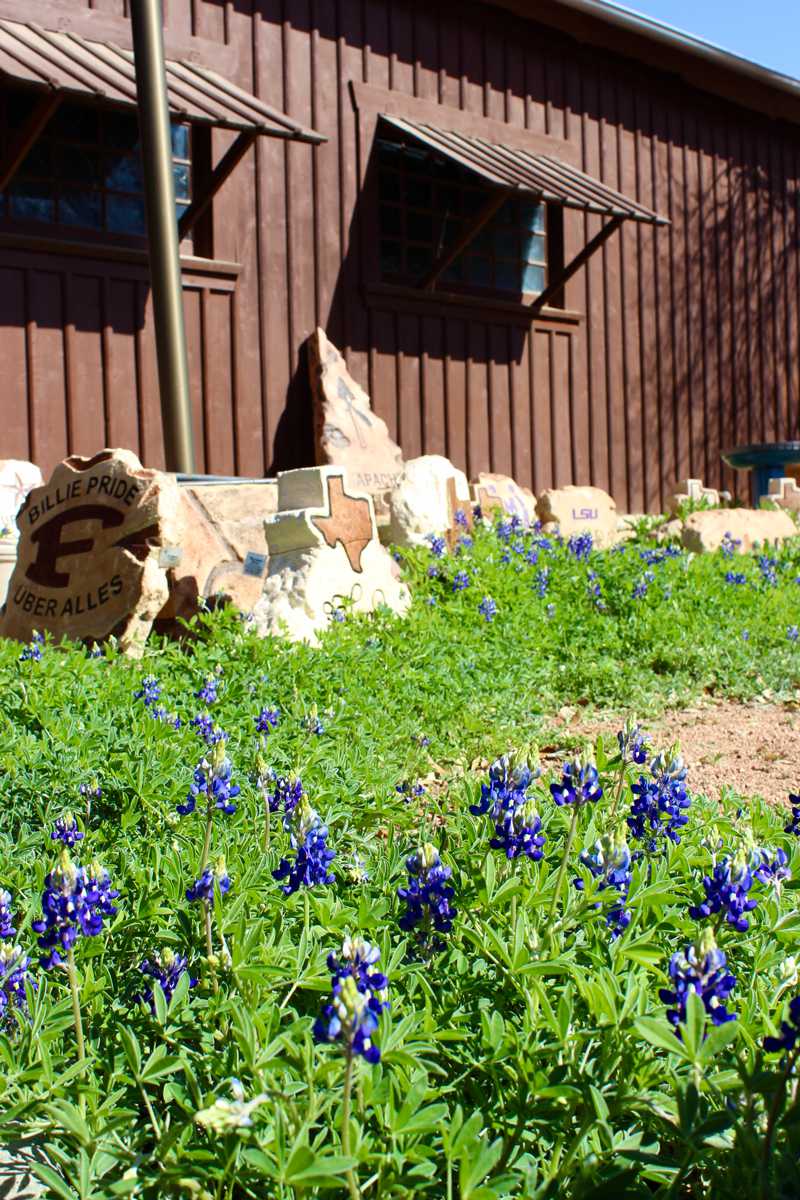
Alexandra Kennon
The biggest show of bluebonnets we saw on this Hill Country excursion was not on the roadside, unfortunately, but at the lovely Wildseed Farms near Fredericksburg.
The bluebonnets were what brought us to Texas a couple of days before our friends’ wedding south of Austin, and kept us a couple of days after they exchanged vows. But at the time of our excursion, the lingering impacts of an unseasonable drought rendered the bluebonnets all but non-existent. Spotting one or two drooping speciments on the roadside, I’d jump with excitement, eagerly alerting my Austin-raised partner Sam, “There!” Each time, he would sigh: “Yeah, but it’s not the same. They’re normally everywhere this time of year. Seas of them.” We heard the sentiment again and again from locals, especially those invested in tourists like us who flock to these hills each spring.
Where we missed the bluebonnets, we found plenty of pit barbecue, country music history, unexpected natural wonders, chicken fried steak, local libations, and colorful characters—making it a much more than worthwhile adventure.
Lone Star Court
The Hill Country is plenty worthwhile on its own accord, but admittedly, the close proximity to Austin is a major asset.
Though Lone Star Court, the boutique hotel where we were staying, is part of North Austin’s upscale shopping area The Domain, its design foreshadowed our more rural Hill Country experience to come. A Tiffany blue vintage Buick Roadmaster (or that’s my guess based on Googling, so don’t come for me, car people) with Texas plates and a sixties motel-style neon sign brandishing “Lone Star Court” greeted us out front. After we checked in inside the smartly cowhide-accented office, a fragrant waft of woodsmoke beckoned from a barbecue smoker on the sprawling covered courtyard: “Welcome to Texas”.
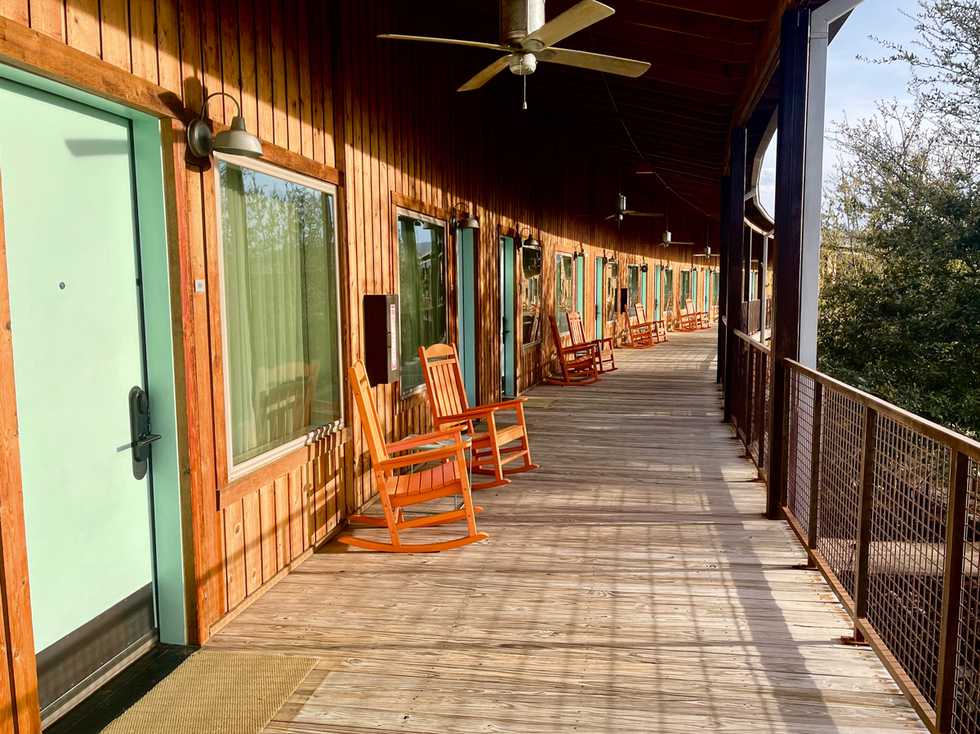
Alexandra Kennon
Lone Star Court in Austin
As if a remote southwest highway motel received a metropolitan education, the accommodations at Lone Star Court have each their own outdoor entrances overlooking the courtyard, outfitted with a pair of rocking chairs and a ceiling fan. The retro motel atmosphere carried into our room, which greeted us with cold Lone Star beers in the vintage-style Smeg refrigerator (the same shade of blue as the Buick) and local salsa and snacks. A sliding barn door to the sleek, pristine bathroom and leather chair with the exposed-wood desk conjured a ranch house feel—the cloud-soft mattress and smooth, cool Egyptian cotton sheets reminded us we were in a luxury hotel in recently-reimagined North Austin.
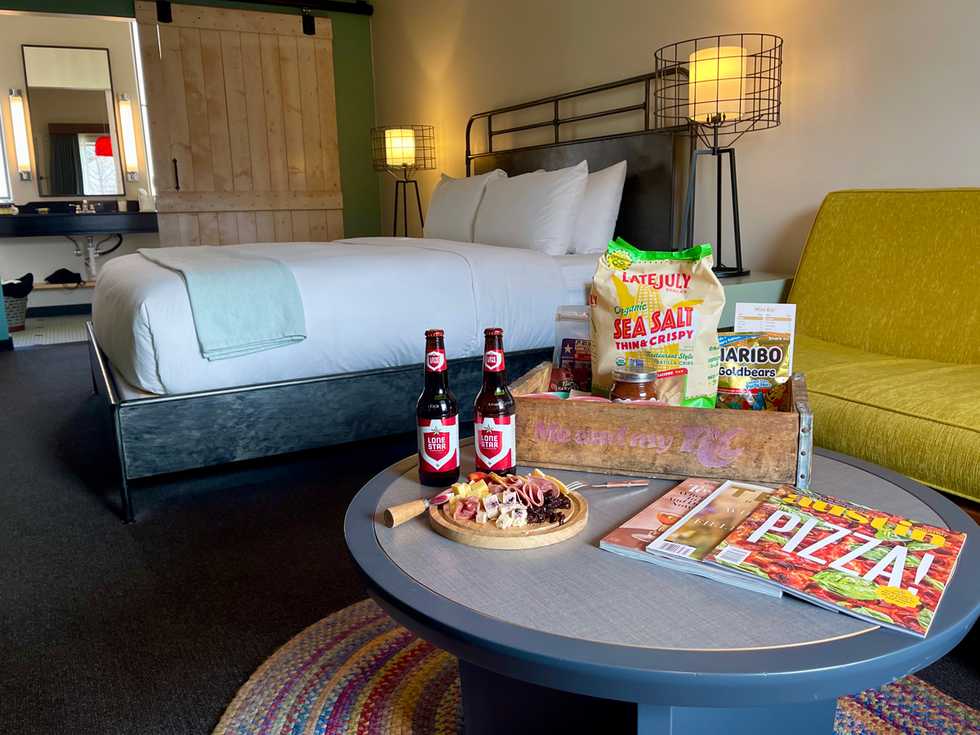
Alexandra Kennon
Lone Star Court
Fredericksburg & Enchanted Rock
We started out early the next morning with the under two-hour drive to Fredericksburg. The further out we got, the subdivisions and shopping centers gave way to long stretches of pasture speckled with cows and cacti, occasionally broken up by ranch houses—longhorn-adorned iron gates protecting their long gravel driveways.
Then, rising up like a Western movie set, came the town of Fredericksburg. Though founded on land originally occupied by Comanche Native Americans, the town received its name, derived from Prince Frederick of Prussia, upon its founding by German settlers in 1846. Today, the downtown length of Main Street stretches flat and picturesque, lined with over 150 locally-owned shops, restaurants, and galleries in historic buildings bearing Texas and German flags.
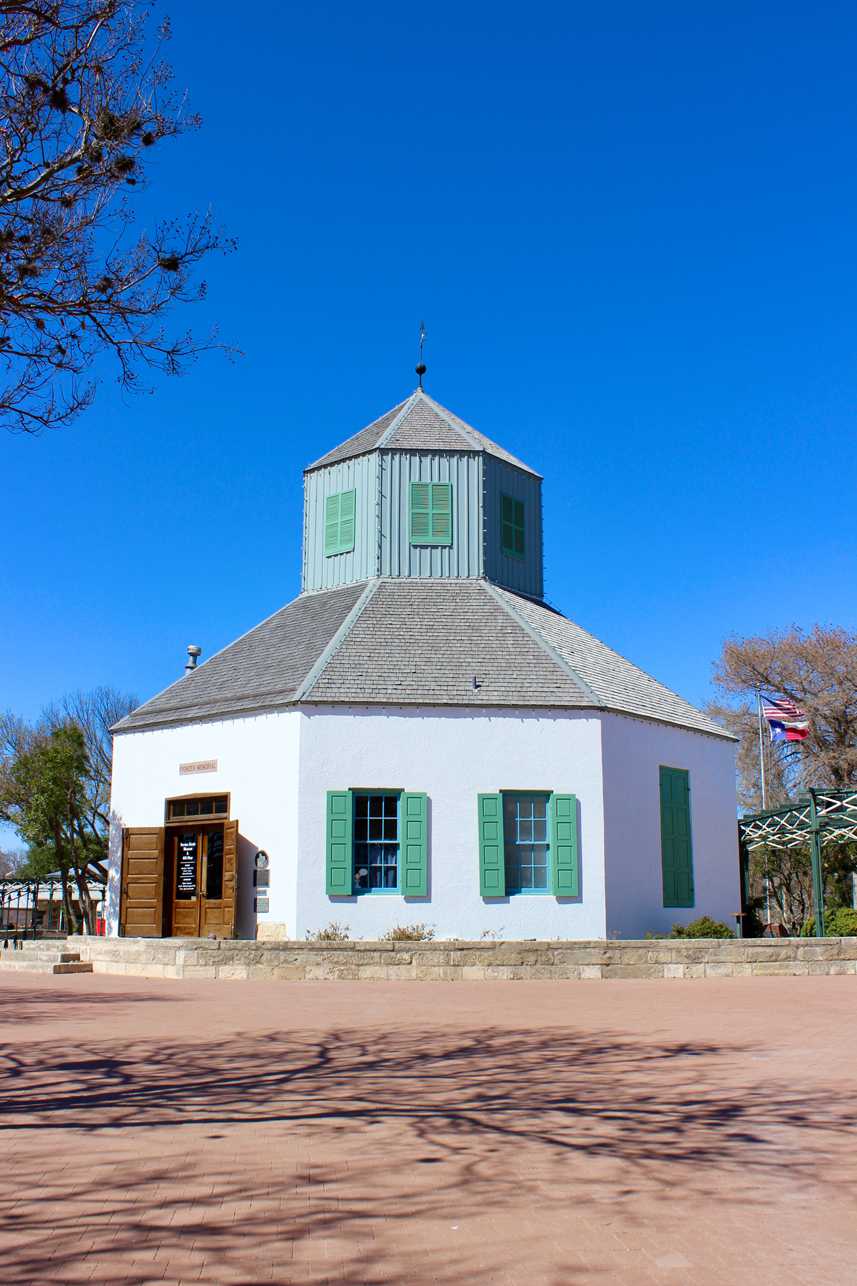
Alexandra Kennon
The Marketplatz Fredericksburg
After a stop by the tourism office, we met Sam’s cousin Gary, a local peach farmer, for breakfast at Caliche Coffee. We were impressed by the wide-ranging menu options that nodded to the Southwest and beyond—Sam went for the earthy red chile-sauced Chilaquiles; I had some kind of yogurt and granola parfait laced with a gingery, citrusy ribbon of fruit; and Gary generously let me snap a photo of his thick avocado toast, loaded with colorful veggie garnishes and boiled egg. As we sipped our coffee on the sunny back deck, Gary told us about the many changes increased tourism has brought to Fredericksburg, and a few things that have stubbornly and gloriously remained the same (like the General Store). It wasn’t lost on me how my being there to write about my visit for a magazine, photographing his avocado toast, was fairly emblematic of the things that Gary cited were fueling this change; he was warm, friendly, and matter-of-factly hospitable regardless.
Next, we headed for Enchanted Rock. The massive, orangey pink granite dome’s name comes from the considerable lore associated with it—local Comanche, Apache, and Tonkawa tribes believed the rock possessed spiritual and magical powers. Legends range from the rock making Native people invisible to aid them in hiding from Anglo settlers, to the Tonkawa believing ghost fires light the top of the dome, and reporting it creaking (which geologists believe is a result of the stone contracting at night after being heated by the sun during the day).
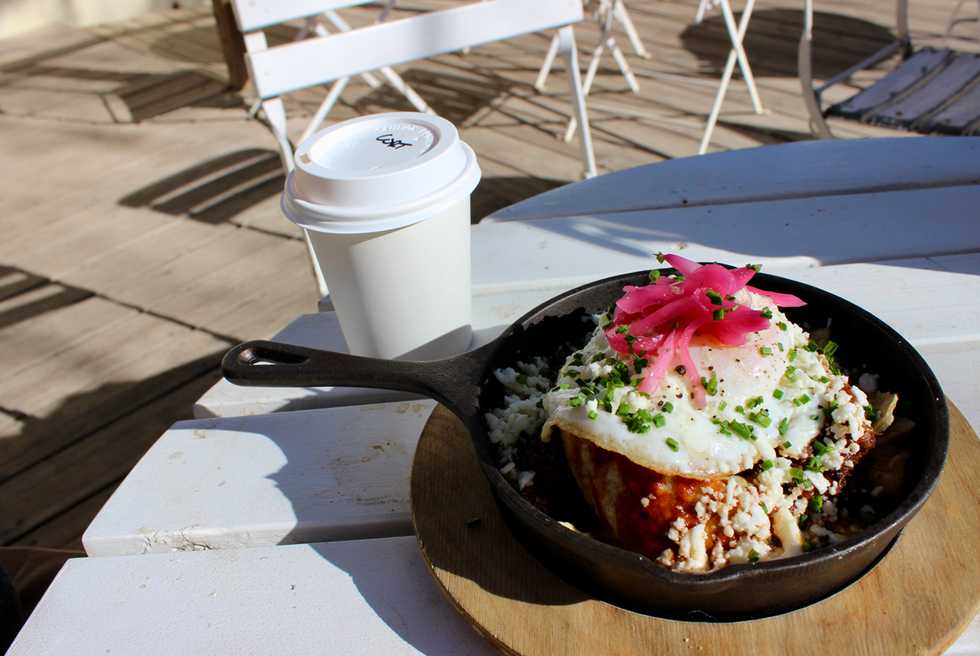
Alexandra Kennon
Chilaquiles at Caliche Coffee in downtown Fredericksburg.
As is true of most Texas State Parks and Natural Areas, reservations at Enchanted Rock are highly recommended since the park closes when it reaches capacity. The park offers around eight and a half miles of hiking trails throughout—experienced hikers can opt to take the full 4.6 mile loop trail, and more leisurely sight-seers can take the 0.1 mile Scenic View Trail or easy 0.3 mile Frontside Trail. With limited time and over-confident estimations of our hiking capabilities, we opted for the fairly challenging 0.8 mile Summit Trail, which takes visitors directly to the top of Enchanted Rock.

Alexandra Kennon
The hike up to Enchanted Rock
The incline was steep enough to be quite invigorating—at least at first—as we galumphed ahead, stopping every hundred yards or so to turn around and marvel at the increasingly-impressive view of the surrounding Hill Country as we ascended. About a third of the way from the top, I had to stop to sit down on a rock. I don’t normally struggle with vertigo, but something about a hike that gradually steep (and my continuous turns to look back down and admire the view) had me a bit lightheaded. After a grounding little water break, we pressed forward to the top—and from the very peak of the mysterious not-quite-mountain, the lofty perspective of the vast, arid landscape around us was well worth the effort. The descent was a quick and pleasant reward for our efforts on the way up.
Feeling accomplished, we headed back into town to meet Gary and his partner Kaye for lunch at Hill & Vine. The “Texas table and wine hall” offers creatively-laid-back, locally-inspired-and-sourced dishes like chicken schnitzel with chimichurri and grilled lemon, a watermelon and green tomato salad with spiced pecans and herbed goat cheese, a Texas cheeseburger with local Wagyu and house-brined pickles, and pimento mac & cheese you can add pulled pork to. We all thoroughly enjoyed our entrées, and I was surprised that when I hesitated to order the Roadside Fried Pies—hand pies made with local peaches and spiced pecans—Gary intervened. He wanted to try them, too. Even having spent much of his life on a peach orchard, he still appreciated the deliciousness of the local bounty—particularly decadent wrapped in its crispy-thin pastry, Texas rum sauce, and local Clear River ice cream.
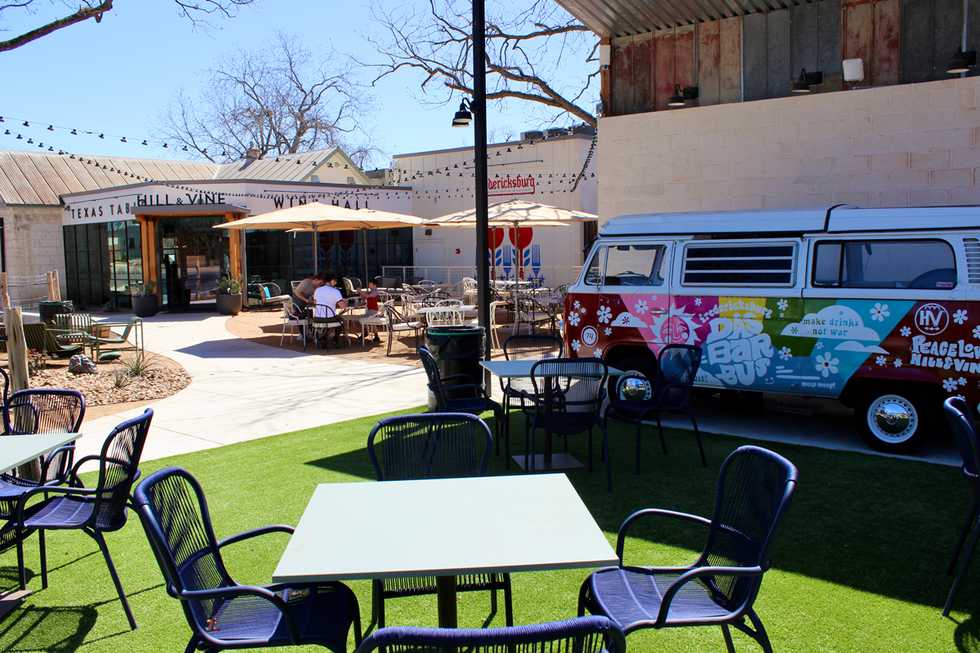
Alexandra Kennon
Hill & Vine in Fredericksburg
After lunch, we moseyed around Fredericksburg’s historic downtown area. We made our obligatory stop in the Marketplatz, the historic park at the center of town that surrounds the Vereins Kirche—an octagonal building that has been rebuilt on the site of Fredericksburg’s first church and school, that today houses a museum of Fredericksburg’s history.
[Planning summer travels? How about Florida? Here's our travel guide along the coast.]
Down the street, Rustlin’ Robs overwhelmed and excited us, with its absurdly varied selection of hot sauces, dip mixes, spices, and more stretching from the floor all the way to the vintage-knick-knack-covered ceiling. Other stores we perused offered everything from women’s clothing, to cowboy boots, to home goods, to chocolate truffles, to gag gifts. Clear River Ice Cream and Bakery touted a huge list of small batch flavors, and claimed to have the “Best Peach Cobbler in Texas” (still full from the hand pies, we were unable to verify).
Speaking of peaches, a little further out from Main Street, Das Peach Haus is worth a visit. The family-owned company Fischer & Wieser Specialty Foods’ jams, jellies, and sauces are long-standing staples of area grocery stores; the current shop sits in the same location as the family’s historic peach stand from 1870, which remains on site. It’s surrounded by tall pine trees, which were planted by a previous generation and remain towering over the sweet wooden shop and Adirondack-surrounded pond out back.
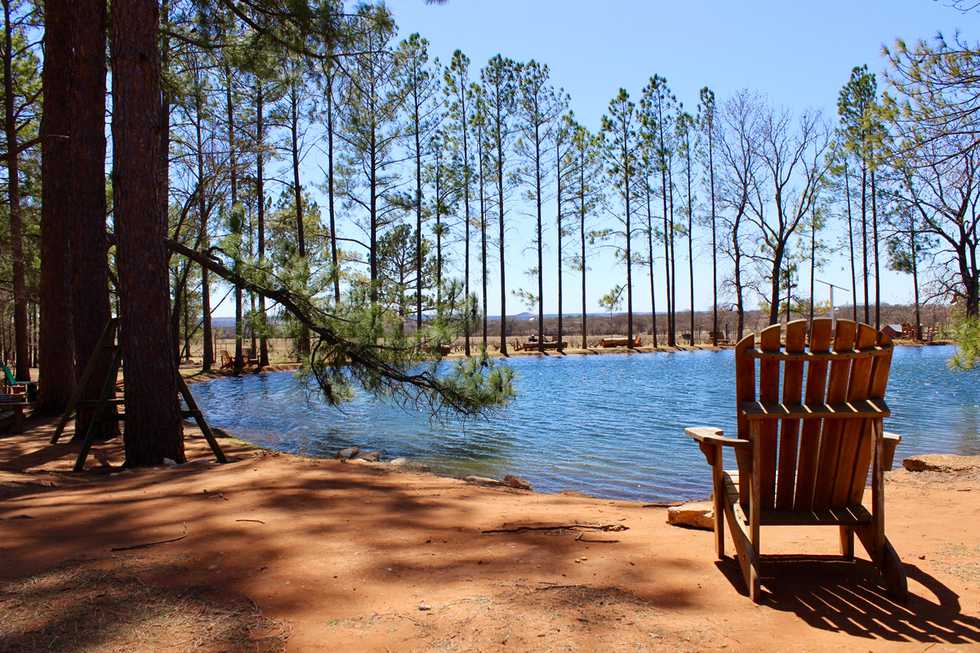
Alexandra Kennon
The Adirondacks just behind Das Peach Haus
Bolstered by its German heritage, Fredericksburg has always been a leader in this country’s craft beer scene—Fredericksburg Brewing Company right on the Main Street stretch has been open since 1994, giving it the distinction of the “Oldest brewpub in Texas”.
Serious beer connoisseurs will also want to prioritize a visit to Altstadt Brewery, opened in 2018 on an impressive Bavarian-inspired campus further out from the downtown stretch. Altstadt’s brewers implement principles of Reinheitsgebot, German beer purity laws that date back to the 1500s, and brew Altstadt’s beers using a copper-plated rolec brewhouse imported from Germany. The restaurant on-site continues the trend of elevated Texas-meets-German-inspired dishes, brewer-led tours are available, live music acts frequently play the Grand Hall, and there’s even a museum of vintage tractors that’s free for visitors to check out.
Beyond beer, the hills surrounding Fritztown propagate a rich vineyard scene—with ample tour options.
We were steered toward Becker Vineyards Estate Tasting Room, one of the more impressive, with its imposing stone facade and fifty-six acres of vineyards on an over-three-hundred-acre estate. While founders Dr. Richard Becker and his wife Bunny were in France studying the Viognier grape (which they would be the first to commercially plant in Texas), they observed the abundance of lavender plants thriving in that dry and arid climate. In 1998, they enlisted their daughter and friends to assist in planting 10,000 lavender plants at their estate vineyard, which has grown to three acres and now includes poppies, bluebonnets, sunflowers, and zinnias. Becker even hosts an annual Lavender Festival, whose twenty-fourth edition will take place the weekend of April 15–16, 2023.
Down 290, Wildseed Farms also offers stunning wild floral displays, with bluebonnets and other wildflowers (when in season) stretching to the horizon, a Brew Bonnet Biergarten, and a cute associated gift shop (we bought a couple of shot glasses with little bluebonnets painted on the side, to drown our sorrows over the drought).
Luckenbach, Willow City Loop & Llano
A full day exploring Fredericksburg under our belts (and still so much left on the table for next time), we headed southeast toward one of the more legendary destinations on our itinerary (in a landscape full of legends, jutting out of the desert like Enchanted Rock). In under twenty minutes, we arrived at Luckenbach: an autonomous zone where country music history and reverence thereof surpass all else on that beer-soaked acreage. It started as a trading post in 1849 that is said to have never broken a peace treaty with the Comanche Native Americans who utilized it alongside German settlers. The small community grew to include a cotton gin, a blacksmith, and a school, and the population increased to nearly five hundred residents at its highest in 1904, before steeply declining over the course of the next several decades. In 1970, an advertisement in a local paper touted “town — pop. 3 — for sale,” which earned the attention of rancher and Texas folklorist/writer Hondo Crouch, rancher Kathy Morgan, and actor Guich Koock, who together bought Luckenbach in 1970 for $30,000. In 1973, Jerry Jeff Walker recorded the groundbreaking country rock record Viva Terlingua in the local Dancehall—that was three years before Waylon Jennings and Willie Nelson would launch Luckenbach to worldwide fame with the hit “Luckenbach Texas (Back to the Basics)”.
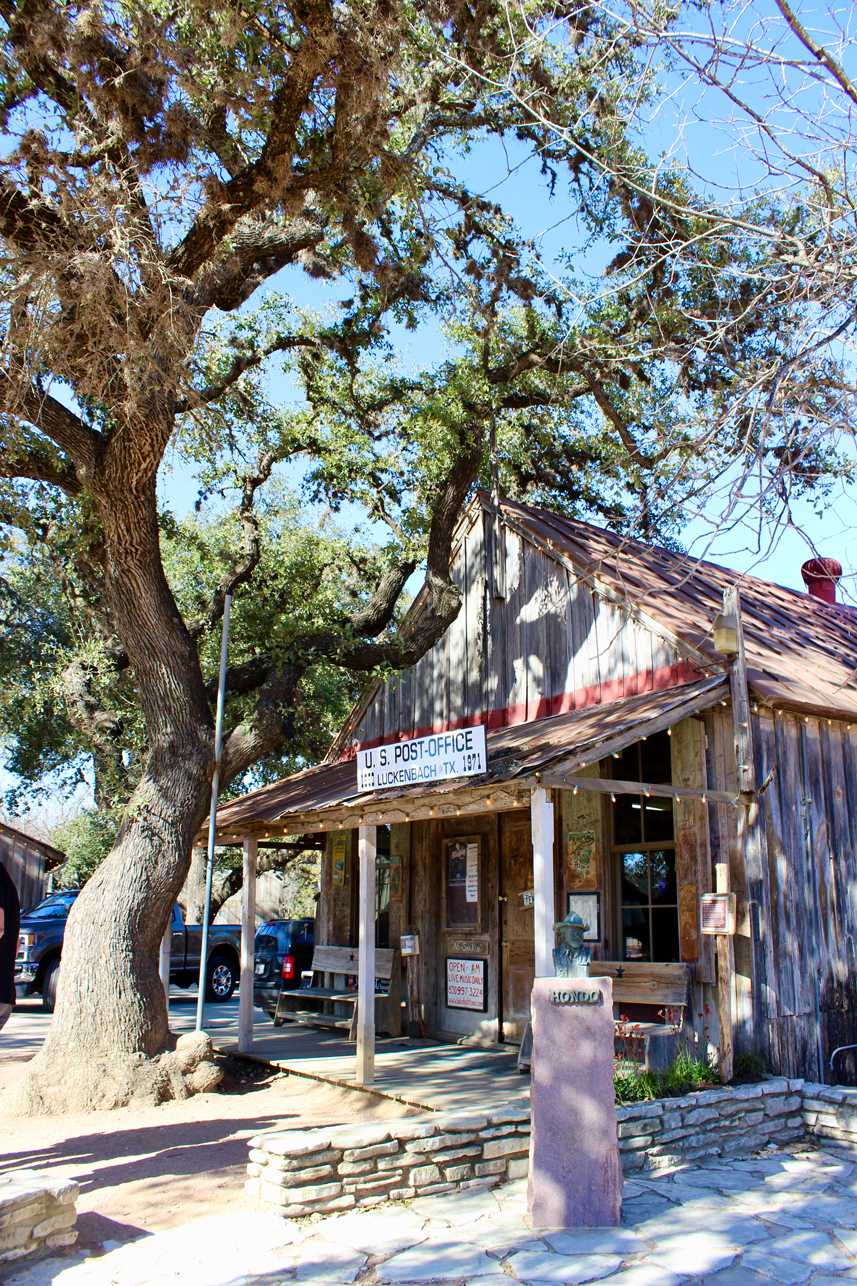
Alexandra Kennon
The Post Office and General Store in Luckenbach.
With its dancehall and funky tree-branch-draped outdoor stages, Luckenbach continues to host regular live country acts for audiences who also enjoy sipping local beer and pursuing the kitschy items in the historic Post Office and General Store. We sat at a picnic table in the shade sipping Altstadt Pilsner watching the weeknight pickers’ circle guitarist play and crack jokes as the sun teased at setting.
Wanting to maximize our remaining daylight and take advantage of already being so far out, we impulsively decided to knock the Willow City Loop off of our itinerary that evening. Willow City Loop is a thirteen-mile meandering drive through some of the most scenic countryside in the Hill Country—the narrow ranch road brought us over creeks, past craggy rock formations, plenty of “loose cattle” signs and what they warn of, and other wildlife. Even though we were too early for the bluebonnets and other wildflowers that make Willow City Loop “the iconic Texas Hill Country scenic drive,” I was captivated by the ruggedly remote landscape.
And then, like a beautiful Texan beacon on that lonely ranch road (one perk of our random evening drive out of season was that we entirely avoided the traffic that can come with such a famous route), there was the road sign, matter-of-factly telling us that Cooper’s Old Time Pit Bar-B-Q in Llano was less than twenty miles north. Having been raised by a Texas barbecue reviewer, Sam extolled the virtues of the legendary joint, and we took off. A young man lording over a vault-like pit holding links of sausage, massive pork chops, quarters of chicken, a sizable brisket, and racks of ribs greeted us. Sam pointed out the exact pork chop and sausage links we wanted and asked him to slice from the fattier side of the brisket. Then we took our tray inside to round up sides of simple ham-hock flavored pinto beans, potato salad, and mac ‘n’ cheese. As we moaned through each smokey, fatty bite of simply-seasoned perfection dunked in thin, porky sauce, a dozen sets of mounted deer eyes upon us, we were reminded of the delicious rewards that often come with willingness to go a few extra miles for something truly special.

Alexandra Kennon
Cooper's Old Time Pit Bar-B-Q
Blanco & Wimberley
The next day, departing from our Austin launchpad one last time, we grabbed migas for breakfast at one of Sam’s no-frills Tex-Mex favorites, Enchiladas Y Mas. Then, back into the Hill Country we went—this time with our sights set on Jacob’s Well Spring at the head of Cypress Creek, northwest of Wimberley. What makes Jacob’s Well notable is its impressive underwater cave that descends vertically for about thirty feet. The crystal clear water allows visitors to see pretty far down the well, which is a popular natural swimming destination. Arriving after a short walk from the parking lot, we found a family enjoying the swimming hole and opted to sit on the walkway and stick our bare feet in the water, as icy cool and clean as its crystal blueness promised, contrasted by the midday sun beating against the back of our necks.
Next, we set our sights on Blanco State Park—only to be seduced along the way by a small red building with a rusty tin roof promising “Homemade Apple Pie”. Like out of a nostalgic dream, the Deutsch Apple Bakery displayed apple pastries of any and every variety, lovingly shaped by hand, beautifully rustic; piled high in the case alongside blackberry pie bars, some local delicacy called butter bars, lemon lavender cookies, and so much more. A kind-eyed older lady piled too many sweets to justify on a road trip into boxes for us, and asked about where we were from. “This might be my favorite bakery ever,” I said incoherently through bites of the thick and crumbly blackberry pie bar back in the car, an assessment I stand by as only slightly hyperbolic. Four days later, when we had returned home to New Orleans, I broke into a loaf of apple pecan bread and marveled anew at how it could still be so moist, so rich in buttery spice.

Alexandra Kennon
The Deutsch Apple
Blanco State Park covers a one-mile stretch of the Blanco River’s banks, where visitors enjoy swimming, picnicking, camping, and bountiful fishing with no license required. We watched as kids and their parents enjoyed walking along the top of a dam and exploring safe and shallow waters nearby, before departing for our lodging near Wimberley.
The restored 1956 Airstream that would be our home for the weekend emerged at the center of a private clearing in the woods—a hammock draped invitingly beside it. We used the provided wagon to deliver bags from the car, and marveled at the Airstream’s restoration—with warm wooden interior details and ‘60s inspired white furnishings, party games, and a cocktail shaker in the window. A separate tin structure housed the bathroom, and a surrounding deck came equipped with a propane grill and hot tub.
The next day was our friends’ big wedding day, and Sam was in the groom’s party. So, while he hustled off to fulfill his groomsman duties of tie-tying and whiskey swigging, I was left to get better acquainted with the hammock and explore downtown Wimberley’s shops on my own. We’d done a bit of preliminary roaming as we drove the winding, tree-shaded country roads coming in the previous day, admiring the homes along the Blanco River and pointing out stray cattle and deer. While the scenery surrounding Fredericksburg and Johnson City was so striking in its open, desert landscape; Wimberley with its plentiful trees and swimming holes evoked a more whimsical, wooded feel.
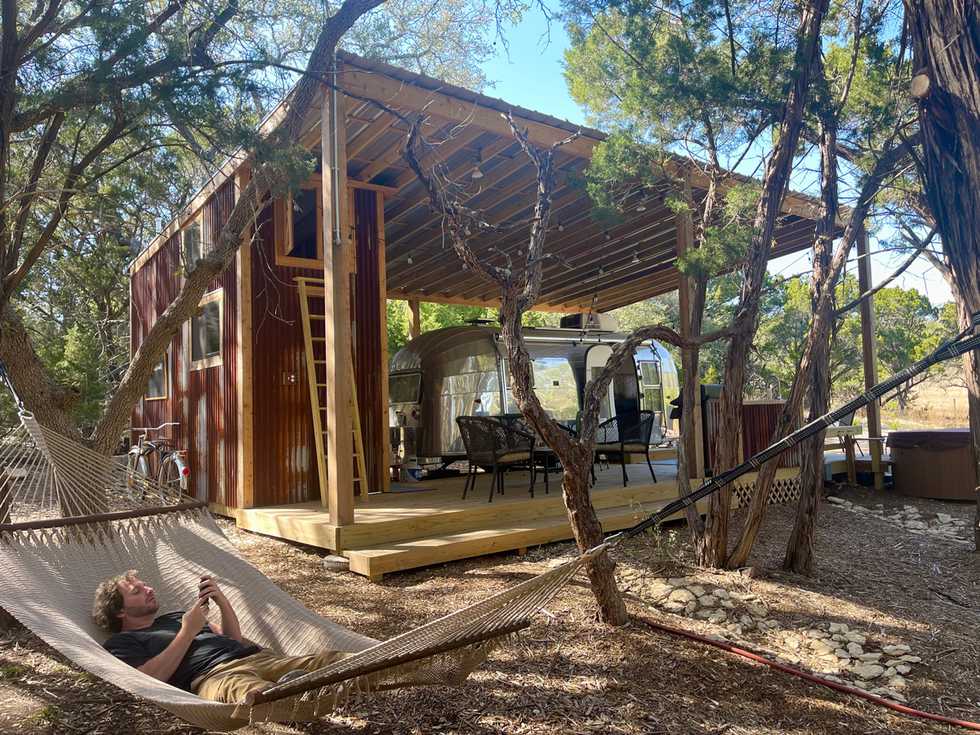
Alexandra Kennon
Shadowland Ranch’s restored 1956 airstream, near Wimberley
I was eager to peruse the funky smattering of shops that seemed to split their allegiance between Western and hippy aesthetics; plenty chaotically incorporating both. Some carried cowboy boots and kitschy coffee mugs, some kept stock a bit more colorful (literally, in some cases—I bought a pair of bright orange socks printed with expletives for a friend). The next morning, I would drag Sam back to show him Los Olivos Market: a Texas wine, craft beer, and olive oil market that sold charcuterie boards and other bites, where I bought a bottle of Texas Hill Country Olive Co. olive oil infused with Harissa and another with white balsamic. Continually on a quest for the elusive bluebonnet, I also grabbed a couple of Texas-shaped wooden magnets with the purplish flowers printed on them at a print shop. “Yeah, that drought has been hard on ‘em this season,” the salesman sighed, wrapping my consolation prize in tissue paper. “You should really come back in a couple weeks.”
The next morning, after some more cloying, crumbling bites of Deutsch Apple delicacies on our deck, we headed to Cypress Falls Swimming Hole—a site we’d noticed advertised on a roadside sign a few days prior. We parked along the blueish green water and ambled up to the open bar/deck/boat rental operation that had clearly received the “funky-fun” memo Wimberley operates on. $8 gives visitors access to the deck and swimming hole all day, and only $10 gets you a canoe, paddle board, or tube rental. I asked the guy who handed us our paddles and helped carry our canoe to the water if we’d need life vests. “You’re overthinkin’ it,” he laughed at me. “It’s like, four feet deep.”
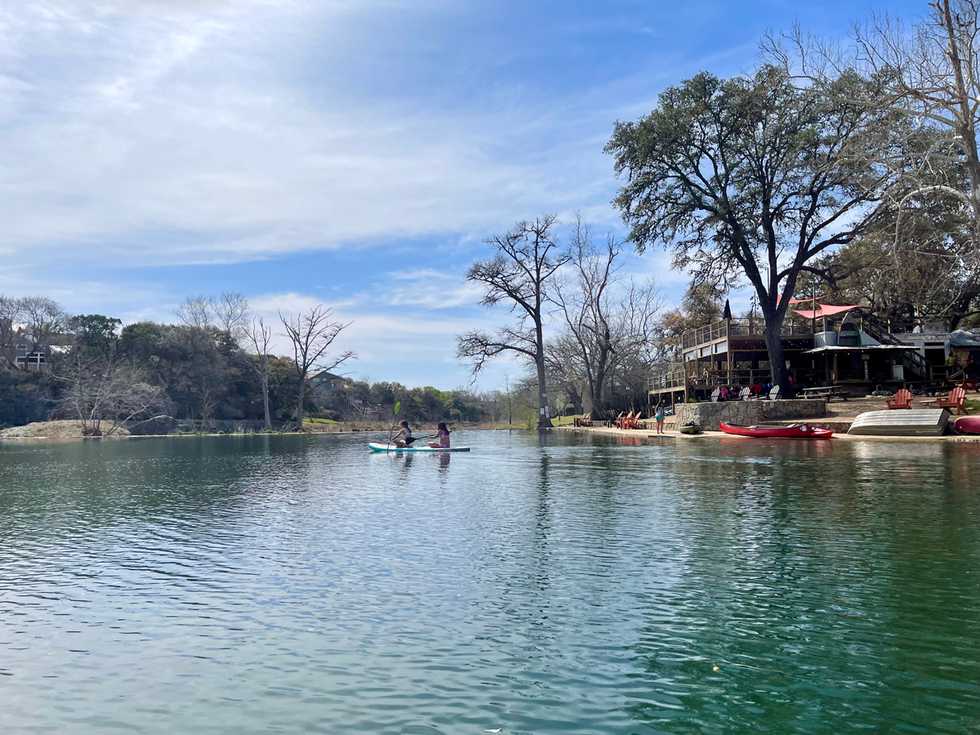
Alexandra Kennon
Cypress Falls Swimming Hole in Wimberley
Comforted, we shoved out onto the sun-reflective water and paddled around leisurely for around an hour, stopping across the way to climb a big natural rock formation before returning the boat. We could have been quite happy sipping local beer and watching the boats and families splash about from a wicker chair on that deck the rest of the afternoon, but it was our last day in the area, and we had more ground to cover.
Suckers for Tex-Mex and particularly susceptible when in the land of it, we grabbed lunch at Durango’s in Wimberley—a bright orange building that called with its promise of “Homemade tortillas” painted on the window. We ordered a plate of huevos smothered in a green chile sauce next to spicy carne guisada, refried beans, hashbrowns, and bacon, and a cup of menudo in the naive hope that we would both forget our disdain for tripe long enough to enjoy the spicy red soup. We agreed that if we were to enjoy menudo, that would have been a good one.
While we were eating, Sam’s buddy Calvin invited us to join him and his dad at nearby Devil’s Backbone Tavern in Fischer. It’s named for The Devil’s Backbone, a limestone ridge in the area that’s known as a scenic-if-incredibly-haunted drive, beloved as a backdrop in Western films.
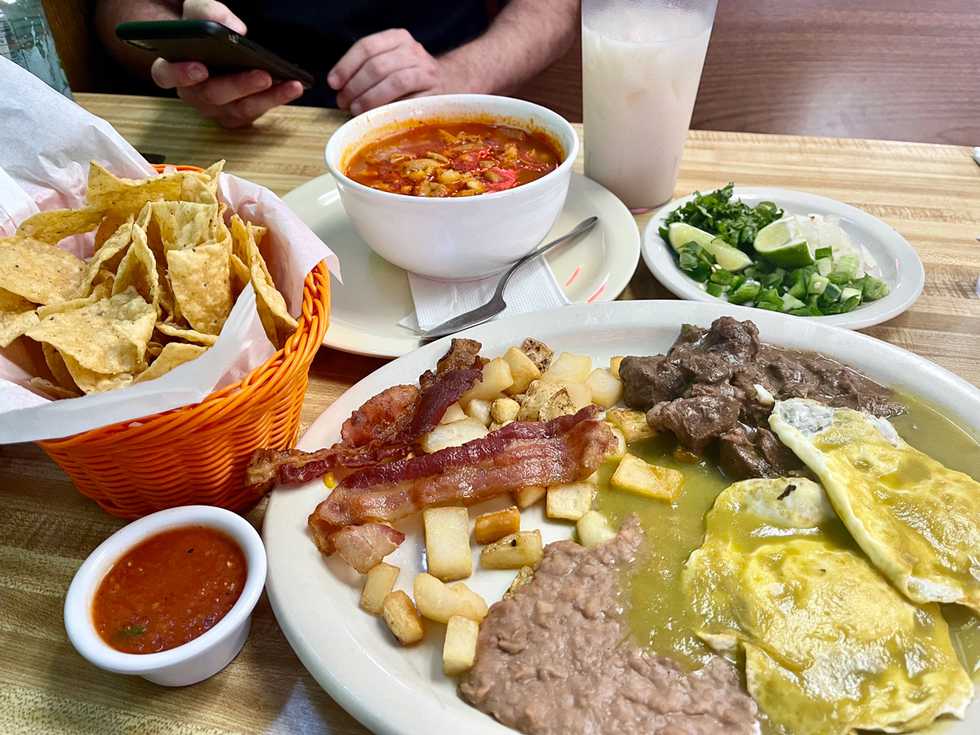
Alexandra Kennon
Durango's in Wimberley
After pulling up to the legendary dive bar and honky tonk dancehall, we walked past the conglomeration of bikers and cowboys and their big slobbery dogs holding court at picnic tables out back. Inside, we were greeted by a dimly-lit world of Lone Star beer, the twang of country music, and allegedly the oldest shuffleboard in Texas (regulation length). Saloon-style vintage light fixtures crusted with dust, lit-up domestic beer signs, a skeleton in a cowboy hat, and hundreds of tattered dollar bills affixed to the ceiling completed the atmosphere. We grabbed glass bottled Lone Stars and moseyed into the dancehall portion, where we listened to the Michael O’Connor band play for a few songs, couples occasionally getting up to dance on this Sunday afternoon. “You didn’t pay nothin’, the least you can do is dance,” O’Connor prodded the crowd. When Calvin and his dad arrived, we joined them for a game of shuffleboard, feeling part of the singular local scene as we took our shots at knocking each other’s pucks off the long, sandy board, cursing between pulls of beer.
Only a quick drive away from Old Baldy, we tackled the short but vigorous hike up a set of stone stairs to the top of what some refer to as “Lookout Mountain”. We aren’t the most skilled hikers, but we do like a nice view—and sure enough, the added elevation from the top provided a beautiful panorama of the surrounding Hill Country, which was worth being a little winded by the two-hundred-twenty steep steps.
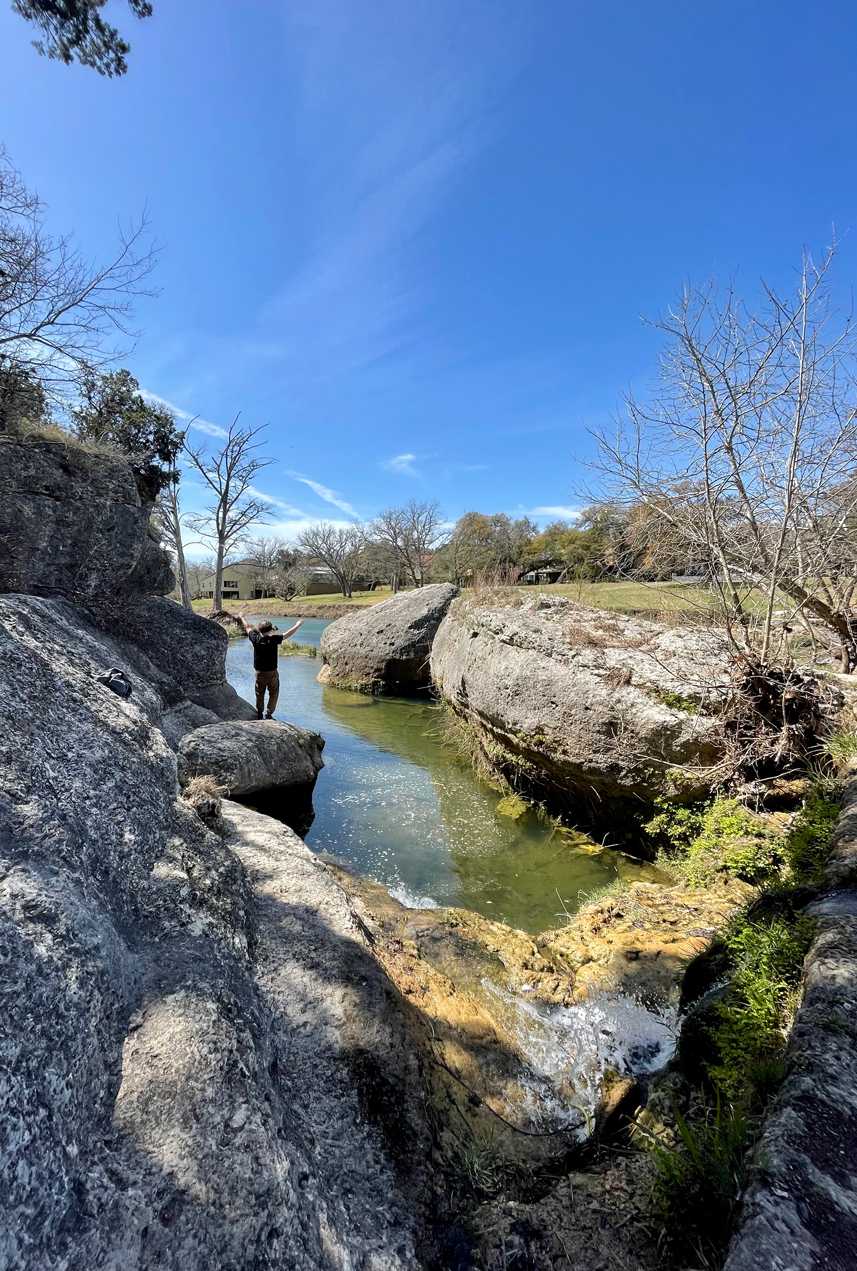
Alexandra Kennon
Cypress Falls Swimming Hole in Wimberley.
Still working to squeeze as much natural beauty as possible into our last day, we headed to Canyon Lake. A reservoir of the Guadalupe River constructed by the Army Corps of Engineers in the 1950s to provide flood control and water for communities south of the Canyon Dam, the massive blue body of water looks pretty out of place in the middle of this dry Texas countryside. That doesn’t stop it from being picturesque, lined with its sandy beaches dotted by sunbathing tourists. We walked along the top of the imposing dam, marveling at the blueness of the water and the rolling hills on the opposite shore.
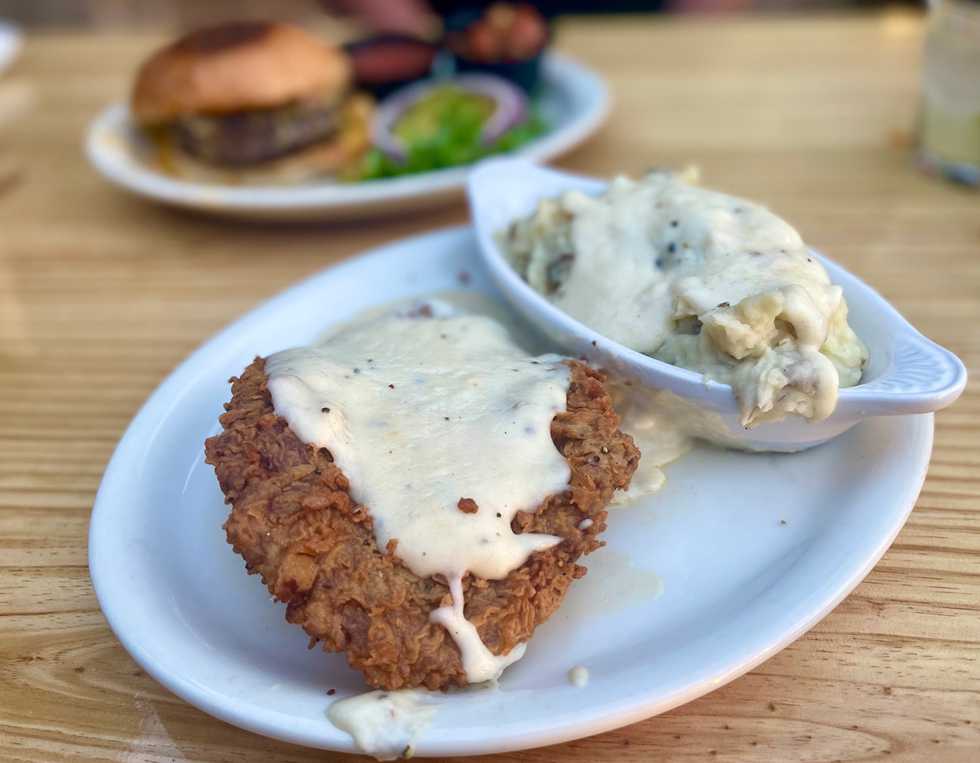
Alexandra Kennon
Chicken Fried Steak at Gristmill in Gruene
Just as we felt our skin turning pink, we hopped in the car and started towards the last Hill Country town on our agenda, which made our list primarily for its legendary chicken fried steak and historic dance hall: Gruene. We passed historic buildings and an eclectic stretch of quirky shops overseen by a big old water tower bearing the town’s name. After making a sweep of the shops, we headed to Gristmill River Restaurant & Bar, where we sought the Hill Country delicacy rivaled only by barbecue: chicken fried steak.
Housed in the historic Gruene Cotton Gin with a back deck overlooking the Guadalupe River, the Gristmill building is worth seeing all on its own—but when our cheery waitress brought out the reason we’d come, I could tell from the shatter-crispy coating and thick, creamy and peppery gravy that Gristmill’s chicken fried steak had been worth the wait. We finished every bite, the expertly-breaded-and-fried meat paired dreamily with the homemade-tasting mashed potatoes and gravy.
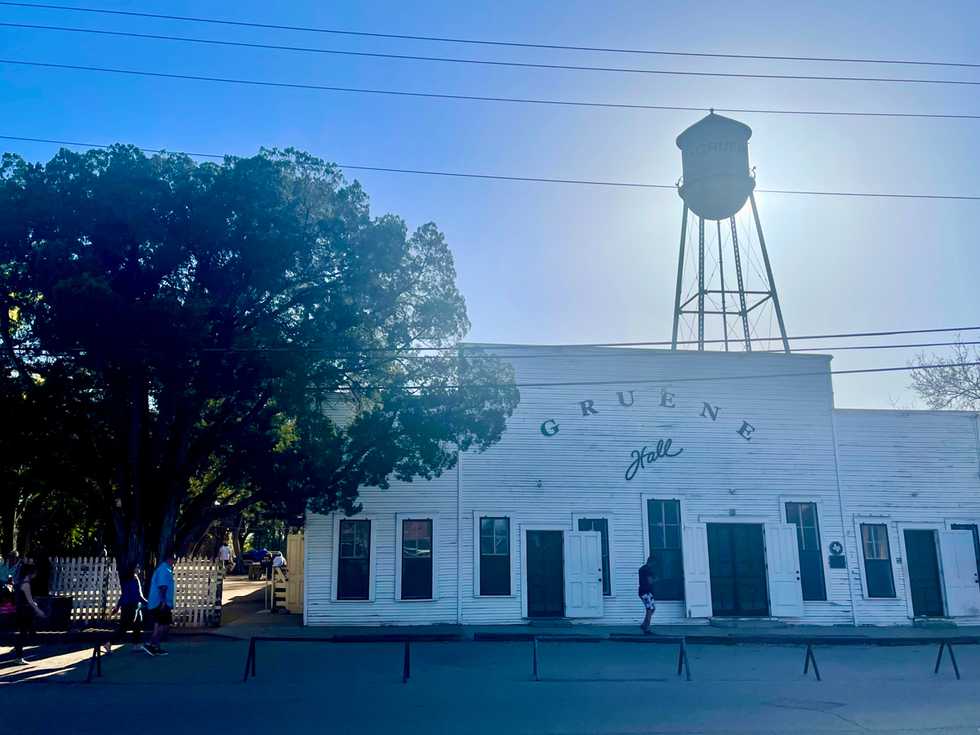
Alexandra Kennon
Gruene Historic Dance Hall
Afterwards, we passed the famous Gruene Hall—the oldest continually-operating dancehall in Texas, which has been hosting honky tonks since 1878, and takes pride in the fact it hasn’t changed a bit. Through the wooden boards of the old hall, country superstar Lyle Lovett’s guitar chords and deep, twangy voice floated out into the Texas night air. Though we hadn’t had the foresight to buy tickets to the sold-out show, just being in close enough proximity to hear him play such an iconic hall was a real thrill. As we drove away from the little town of Gruene that night, Sam played Lyle Lovett’s songs over the car speakers, and one in particular felt like the perfect note on which to end our trip ambling around the Hill Country:
“That’s right, you’re not from Texas
But Texas wants you anyway.”
There is so much to see and do in the sprawling Texas Hill Country, that our experience barely scratches the surface.
Disclaimer: This trip was hosted in part by Lone Star Court and Visit Fredericksburg, though the opinions of the writer are entirely her own.
Note: Gary Marburger, Sam’s second cousin who owned the peach farm outside of Fredericksburg, sadly passed away a week after our visit. We are so grateful to him and his partner Kaye for their warm hospitality. In his obituary, next to a photo of him smiling wide holding a bowl of peaches and following his extensive local volunteer work, it notes that, “he found himself happiest among dear friends and his peach trees in the Texas Hill Country.”

